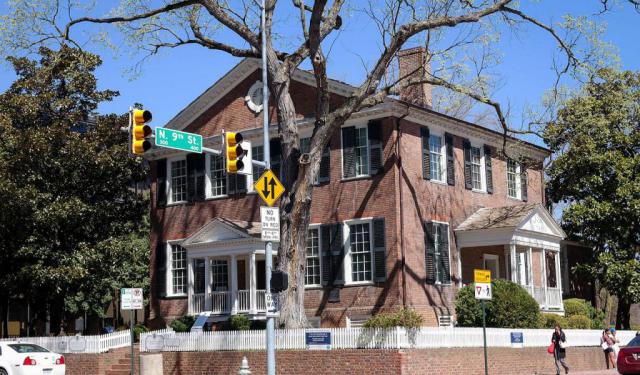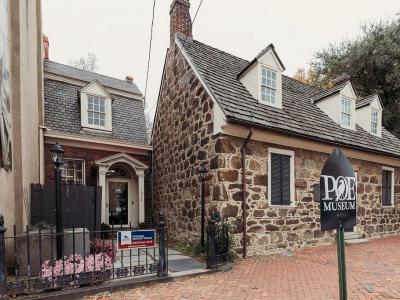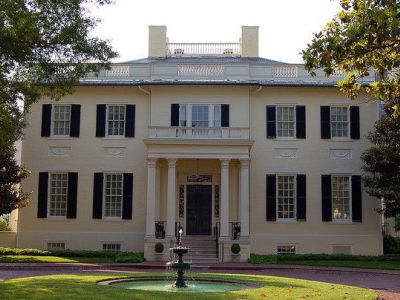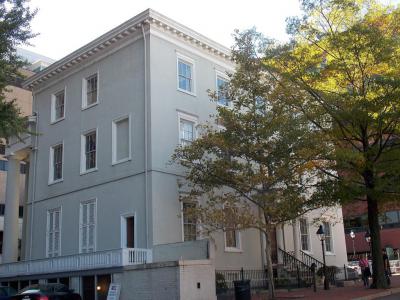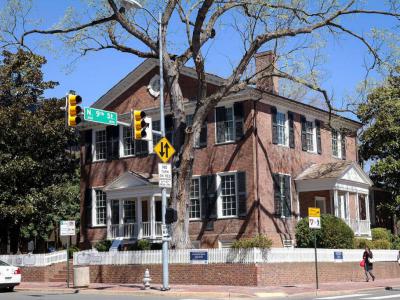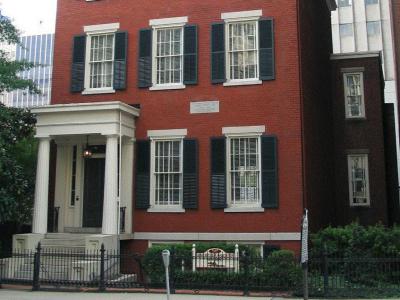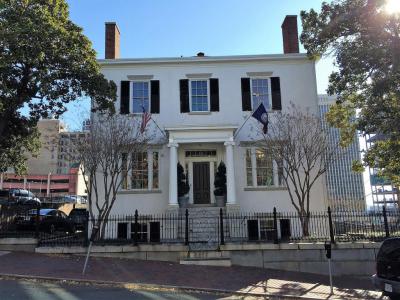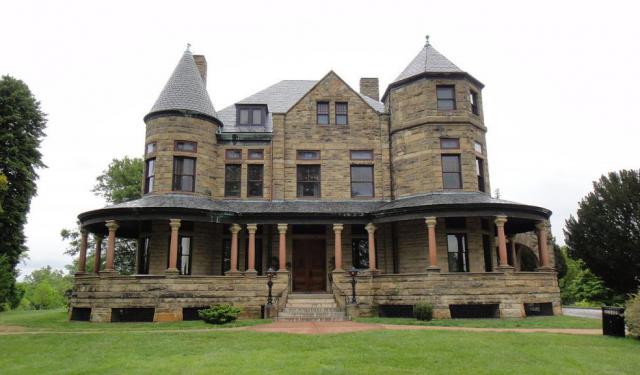Historical Homes Walking Tour (Self Guided), Richmond
Being one of America’s oldest major cities, the capital of Virginia, Richmond, is rich with historic homes, dating back well into the 1800s and beyond. Those passionate about storied buildings will surely find plenty to their taste here.
The Edgar Allan Poe Museum, The White House of the Confederacy – home of Confederate President Jefferson Davis during the Civil War, and the John Marshall House in Court End – a neighborhood known for Federal-style mansions, are just some of the most notable sights awaiting visitors on this self-guided walk.
Another architectural treasure is the Governor's Mansion. Built in 1813, it serves as the official abode of Virginia's governor, remaining the oldest gubernatorial residence in the nation still in use.
The Putney Houses, a pair of charming mid-19th-century dwellings, exemplify Italianate-style townhouse architecture. These structures offer an idea of how Richmond's early elite used to live.
The Stewart-Lee House, where Confederate General Robert E. Lee once resided, stands as a symbol of the Civil War's impact on Richmond and the nation.
Finally, the Barret House, an antebellum mansion, represents Greek Revival architecture and provides a glimpse into the opulent lifestyles of pre-Civil War Richmond.
History enthusiasts and curious visitors may find it equally interesting to explore these locations and immerse themselves in the rich tapestry of Richmond's storied past. Plan your visit today and step back in time to experience the beauty and significance of these historical homes.
The Edgar Allan Poe Museum, The White House of the Confederacy – home of Confederate President Jefferson Davis during the Civil War, and the John Marshall House in Court End – a neighborhood known for Federal-style mansions, are just some of the most notable sights awaiting visitors on this self-guided walk.
Another architectural treasure is the Governor's Mansion. Built in 1813, it serves as the official abode of Virginia's governor, remaining the oldest gubernatorial residence in the nation still in use.
The Putney Houses, a pair of charming mid-19th-century dwellings, exemplify Italianate-style townhouse architecture. These structures offer an idea of how Richmond's early elite used to live.
The Stewart-Lee House, where Confederate General Robert E. Lee once resided, stands as a symbol of the Civil War's impact on Richmond and the nation.
Finally, the Barret House, an antebellum mansion, represents Greek Revival architecture and provides a glimpse into the opulent lifestyles of pre-Civil War Richmond.
History enthusiasts and curious visitors may find it equally interesting to explore these locations and immerse themselves in the rich tapestry of Richmond's storied past. Plan your visit today and step back in time to experience the beauty and significance of these historical homes.
How it works: Download the app "GPSmyCity: Walks in 1K+ Cities" from Apple App Store or Google Play Store to your mobile phone or tablet. The app turns your mobile device into a personal tour guide and its built-in GPS navigation functions guide you from one tour stop to next. The app works offline, so no data plan is needed when traveling abroad.
Historical Homes Walking Tour Map
Guide Name: Historical Homes Walking Tour
Guide Location: USA » Richmond (See other walking tours in Richmond)
Guide Type: Self-guided Walking Tour (Sightseeing)
# of Attractions: 7
Tour Duration: 2 Hour(s)
Travel Distance: 3.1 Km or 1.9 Miles
Author: damon
Sight(s) Featured in This Guide:
Guide Location: USA » Richmond (See other walking tours in Richmond)
Guide Type: Self-guided Walking Tour (Sightseeing)
# of Attractions: 7
Tour Duration: 2 Hour(s)
Travel Distance: 3.1 Km or 1.9 Miles
Author: damon
Sight(s) Featured in This Guide:
- Old Stone House (Edgar Allan Poe Museum)
- Governor's Mansion
- Putney Houses
- White House of the Confederacy
- John Marshall House
- Stewart–Lee House
- Barret House
1) Old Stone House (Edgar Allan Poe Museum) (must see)
Dedicated to Edgar Allan Poe's years spent in Richmond, the Old Stone House features an extensive collection of memorabilia from the writer's time. The house was built around 1740 and holds the title of Richmond's oldest home. While the poet never lived in this actual home, it stands very near where he did live and is indicative of homes of the time. Poe's mother is buried in the Saint John's Church graveyard a few blocks away. Inside the Old Stone House, you'll find furniture from Poe's home and that of his sister, Rosalie Mackenzie Poe.
Inside the other buildings, you'll find more exhibits, including several first editions and manuscripts. There is an exhibit on the mysteries surrounding Poe's death, on which there have been no fewer than 26 theories published over the years.
The movement to create a museum started in 1906 when a group of locals wanted to bring more attention to the famous local poet. The Poe Memorial Association, as they became known, worked to save various bits of Poe's existence in Richmond. They were unable to save the Souther Literary Magazine building, where he began his journalism career. Still, they were able to save bits and pieces to begin creating Poe's Enchanted Garden. The organization eventually rebranded themselves the Poe Foundation, and as their collection grew, they expanded into adjoining structures.
Why You Should Visit:
Fans of Poe's work won't want to miss this glimpse into his early life living and working in Richmond. The museum now houses the most comprehensive collection of Poe memorabilia in the world.
History buffs will delight in the historic Old Stone House, as well as period artifacts.
Tips:
The museum exhibits are self-guided, so you can take it at your own pace. If you'd like a more in-depth experience, ask about their guided tours.
Inside the other buildings, you'll find more exhibits, including several first editions and manuscripts. There is an exhibit on the mysteries surrounding Poe's death, on which there have been no fewer than 26 theories published over the years.
The movement to create a museum started in 1906 when a group of locals wanted to bring more attention to the famous local poet. The Poe Memorial Association, as they became known, worked to save various bits of Poe's existence in Richmond. They were unable to save the Souther Literary Magazine building, where he began his journalism career. Still, they were able to save bits and pieces to begin creating Poe's Enchanted Garden. The organization eventually rebranded themselves the Poe Foundation, and as their collection grew, they expanded into adjoining structures.
Why You Should Visit:
Fans of Poe's work won't want to miss this glimpse into his early life living and working in Richmond. The museum now houses the most comprehensive collection of Poe memorabilia in the world.
History buffs will delight in the historic Old Stone House, as well as period artifacts.
Tips:
The museum exhibits are self-guided, so you can take it at your own pace. If you'd like a more in-depth experience, ask about their guided tours.
2) Governor's Mansion
The Virginia Executive Mansion was built in 1813 and is the oldest governor's house in the nation that is still used for its intended purpose. Best of all, the mansion can be toured on a limited basis. For details, see the Capitol Visitors Center. Tours of the mansion are completed with docents in each room and last about 30 minutes. The current governor and his family do live here, so there is a chance you will see them out and about.
The home is a classic example of Federal-style architecture, designed by Alexander Parris. The house has been beautifully restored to appear as it did in the 1830s, but it not features more living space and is compliant with the Americans with Disabilities Act.
The house is full of history. Three US presidents have resided here at one time or another. Both Presidents Monroe and Tyler served as governor of the Commonwealth before their time in Washington, while William Henry Harrison lived there as the son of Benjamin Harrison. Interestingly, Governor Tim Kaine's wife, Anne Holton, lived in the mansion twice. She happens to be the daughter of former governor A. Linwood Holton Jr.
The gardens around the mansion are impressive too, and they host many events throughout the year. The house has made several appearances on popular TV over the years, including when Virginia First Lady Anne Holton hosted an American Idol finalist from Richmond and when Bob Vila featured the remodeling work on Home Again. Many distinguished visitors have stepped through this house's doors, including Queen Elizabeth II, many US presidents, and Charles Lindbergh. The home is a National Historic Landmark and is on the National Register of Historic Places.
The home is a classic example of Federal-style architecture, designed by Alexander Parris. The house has been beautifully restored to appear as it did in the 1830s, but it not features more living space and is compliant with the Americans with Disabilities Act.
The house is full of history. Three US presidents have resided here at one time or another. Both Presidents Monroe and Tyler served as governor of the Commonwealth before their time in Washington, while William Henry Harrison lived there as the son of Benjamin Harrison. Interestingly, Governor Tim Kaine's wife, Anne Holton, lived in the mansion twice. She happens to be the daughter of former governor A. Linwood Holton Jr.
The gardens around the mansion are impressive too, and they host many events throughout the year. The house has made several appearances on popular TV over the years, including when Virginia First Lady Anne Holton hosted an American Idol finalist from Richmond and when Bob Vila featured the remodeling work on Home Again. Many distinguished visitors have stepped through this house's doors, including Queen Elizabeth II, many US presidents, and Charles Lindbergh. The home is a National Historic Landmark and is on the National Register of Historic Places.
3) Putney Houses
The Putney Houses in Richmond encompass two significant historic homes built in 1859, both reflecting distinct architectural styles and functions in their era. Located at 1010 and 1012 East Marshall Street, these homes were the residences of Samuel and Stephen Putney, a father and son duo known for their shoe manufacturing business from 1862 to 1894.
Samuel Putney House at 1010 East Marshall Street is a quintessential example of Italianate architecture. This three-story, three-bay townhouse is notable for its intricate architectural details and a one-story porch with delicate cast ironwork. The porch spans the front of the first floor, showcasing the period's craftsmanship.
Adjacent to it is the Stephen Putney House at 1012 East Marshall Street. This structure also spans three stories and three bays but is constructed with stuccoed brick. Its distinctive feature is a two-story verandah on the east side, adorned with ornamental ironwork produced by the local Phoenix Iron Works. This element highlights the home as one of the most ambitious examples of domestic ironwork in Richmond, a city renowned for its cast iron detailing.
Both houses boast extensive rear ells and have been preserved and restored, integrating them into the urban fabric of Richmond. Since their designation in 1969 to the National Register of Historic Places, these homes have been adapted for use as office spaces by Virginia Commonwealth University.
Samuel Putney House at 1010 East Marshall Street is a quintessential example of Italianate architecture. This three-story, three-bay townhouse is notable for its intricate architectural details and a one-story porch with delicate cast ironwork. The porch spans the front of the first floor, showcasing the period's craftsmanship.
Adjacent to it is the Stephen Putney House at 1012 East Marshall Street. This structure also spans three stories and three bays but is constructed with stuccoed brick. Its distinctive feature is a two-story verandah on the east side, adorned with ornamental ironwork produced by the local Phoenix Iron Works. This element highlights the home as one of the most ambitious examples of domestic ironwork in Richmond, a city renowned for its cast iron detailing.
Both houses boast extensive rear ells and have been preserved and restored, integrating them into the urban fabric of Richmond. Since their designation in 1969 to the National Register of Historic Places, these homes have been adapted for use as office spaces by Virginia Commonwealth University.
4) White House of the Confederacy (must see)
Tucked away in the Court End neighborhood not far from Capitol Square is the Jefferson Davis Executive Mansion. During the Civil War, the house was considered the Confederate States of America's counterpart to the White House in Washington, DC. Jefferson Davis was the sole president of the Confederacy, and he lived here from 1861 to 1865.
The house was built in 1818 and is a gray stucco mansion built in the neoclassical style. Robert Mills designed it for John Brockenbrough, president of the Bank of Virginia. Being so close to the State Capitol, the neighborhood was full of high-level politicians and wealthy townspeople. Brockenbrough sold in 1844, and the house changed hands several times. It was eventually sold to the city, who rented it to the Confederate government for use as the Executive Mansion.
The Jefferson family and their staff abandoned the house as Richmond was evacuated in 1865. The house was taken intact, and President Lincoln toured the home and held several meetings with local officials. Lincoln spent several hours touring the home, but he did not go beyond the downstairs floor as he felt doing so would be an invasion of privacy.
When the city announced that they planned to destroy the building in 1890, the Confederate Memorial Literary Society was formed to save the mansion. It became the Museum of the Confederacy for over 80 years. After a complete restoration in the 1980s that returned the entire structure to its wartime appearance, the building became known as the White House of the Confederacy and is part of the American Civil War Museum, which is located off-site. Today the house stands alone, surrounded by the VCU medical campus.
Why You Should Visit:
The house has been masterfully restored to appear as it did during wartime. The exhibit House of the Lost Cause explores the history of the Confederacy through Jefferson Davis and his daughter, Winnie Davis, with some of their personal items on display.
Tips:
Plan to spend about 45 minutes or so touring the mansion. Since you're visiting the area, consider combining this tour with a visit to The Valentine, Richmond's history museum.
The house was built in 1818 and is a gray stucco mansion built in the neoclassical style. Robert Mills designed it for John Brockenbrough, president of the Bank of Virginia. Being so close to the State Capitol, the neighborhood was full of high-level politicians and wealthy townspeople. Brockenbrough sold in 1844, and the house changed hands several times. It was eventually sold to the city, who rented it to the Confederate government for use as the Executive Mansion.
The Jefferson family and their staff abandoned the house as Richmond was evacuated in 1865. The house was taken intact, and President Lincoln toured the home and held several meetings with local officials. Lincoln spent several hours touring the home, but he did not go beyond the downstairs floor as he felt doing so would be an invasion of privacy.
When the city announced that they planned to destroy the building in 1890, the Confederate Memorial Literary Society was formed to save the mansion. It became the Museum of the Confederacy for over 80 years. After a complete restoration in the 1980s that returned the entire structure to its wartime appearance, the building became known as the White House of the Confederacy and is part of the American Civil War Museum, which is located off-site. Today the house stands alone, surrounded by the VCU medical campus.
Why You Should Visit:
The house has been masterfully restored to appear as it did during wartime. The exhibit House of the Lost Cause explores the history of the Confederacy through Jefferson Davis and his daughter, Winnie Davis, with some of their personal items on display.
Tips:
Plan to spend about 45 minutes or so touring the mansion. Since you're visiting the area, consider combining this tour with a visit to The Valentine, Richmond's history museum.
5) John Marshall House
The John Marshall House, located on East Marshall Street in Richmond, serves as a historic house museum and is recognized as a National Historic Landmark. This notable residence was the home of Chief Justice John Marshall, a key figure in early American history and a Founding Father, who was appointed to the Supreme Court in 1801 by President John Adams. John Marshall is renowned for his role in landmark cases such as Marbury versus Madison and McCulloch versus Maryland. He lived in this house until he died in 1835.
Constructed in 1790, the Federal-style brick building was the family home for Marshall, his wife Mary Willis Ambler Marshall, affectionately known as Polly, and their six children. The design and layout of the house are reflective of the era, featuring a dining room, parlor, and a combined parlor/dining room on the first floor, with three chambers on the second floor. Originally, the property included several outbuildings like a law office, kitchen, laundry, and stables, and occupied a full city block in the fashionable Court End area of Richmond.
The house's exterior is modest and straightforward, while the interior showcases the period's typical hand-carved woodwork. Notable interior features include wood panels, small cupboards next to the chimneys in the parlor and library, and ornate cornices and mantles in the dining room. Despite some criticism of the room layout as being somewhat haphazard, the overall character of the rooms has been praised for their brightness and pleasing proportions.
Today, the John Marshall House is open to the public for drop-in tours during certain seasons and available throughout the year by appointment for special events, allowing visitors to explore the life and legacy of one of America's influential judicial figures in his authentic historical setting.
Constructed in 1790, the Federal-style brick building was the family home for Marshall, his wife Mary Willis Ambler Marshall, affectionately known as Polly, and their six children. The design and layout of the house are reflective of the era, featuring a dining room, parlor, and a combined parlor/dining room on the first floor, with three chambers on the second floor. Originally, the property included several outbuildings like a law office, kitchen, laundry, and stables, and occupied a full city block in the fashionable Court End area of Richmond.
The house's exterior is modest and straightforward, while the interior showcases the period's typical hand-carved woodwork. Notable interior features include wood panels, small cupboards next to the chimneys in the parlor and library, and ornate cornices and mantles in the dining room. Despite some criticism of the room layout as being somewhat haphazard, the overall character of the rooms has been praised for their brightness and pleasing proportions.
Today, the John Marshall House is open to the public for drop-in tours during certain seasons and available throughout the year by appointment for special events, allowing visitors to explore the life and legacy of one of America's influential judicial figures in his authentic historical setting.
6) Stewart–Lee House
The Stewart-Lee House, also known as the Norman Stewart House, is a significant historical site located in Richmond. Constructed in 1844 by Norman Stewart, a wealthy Scottish tobacco merchant, this residence is an exemplary model of the Greek Revival architectural style prevalent during that era. The three-story, brick townhouse is distinguished by its three-bay structure and low-hipped roof, which is complemented by four interior end chimneys and a simple molded cornice with a plain frieze.
The Stewart-Lee House, once part of "Stewart’s Row," is the only remaining building from the original five constructed by Stewart. Known for its shoebox shape and efficient use of space, its historical significance is enhanced by its connection to General Robert E. Lee. After losing their Arlington property in 1864, Lee's wife and daughter moved into the house. Lee himself briefly resided there from April to June 1865, after surrendering at Appomattox, leaving due to the disturbance from continuous visitors. The house underwent various uses through the late 19th and 20th centuries, was donated to the Virginia Historical Society in 1893, and transferred to the Confederate Memorial Literary Society in 1961. It was recognized on the National Register of Historic Places in 1972 for its historical and architectural value.
Today, the building’s surroundings have dramatically changed, now juxtaposed against modern structures like a fifteen-story office building and surrounded by a parking lot. Despite these changes, features such as a Greek-fret patterned cast-iron fence and a small portico preserve its historical essence. The house underwent extensive renovations in 2001 led by the Home Builders Association of Virginia, which currently uses the building as offices. These renovations have played a crucial role in preserving the architectural dignity and historical narrative of the Stewart-Lee House, allowing it to stand as a testament to Richmond's rich past amidst its modern landscape.
The Stewart-Lee House, once part of "Stewart’s Row," is the only remaining building from the original five constructed by Stewart. Known for its shoebox shape and efficient use of space, its historical significance is enhanced by its connection to General Robert E. Lee. After losing their Arlington property in 1864, Lee's wife and daughter moved into the house. Lee himself briefly resided there from April to June 1865, after surrendering at Appomattox, leaving due to the disturbance from continuous visitors. The house underwent various uses through the late 19th and 20th centuries, was donated to the Virginia Historical Society in 1893, and transferred to the Confederate Memorial Literary Society in 1961. It was recognized on the National Register of Historic Places in 1972 for its historical and architectural value.
Today, the building’s surroundings have dramatically changed, now juxtaposed against modern structures like a fifteen-story office building and surrounded by a parking lot. Despite these changes, features such as a Greek-fret patterned cast-iron fence and a small portico preserve its historical essence. The house underwent extensive renovations in 2001 led by the Home Builders Association of Virginia, which currently uses the building as offices. These renovations have played a crucial role in preserving the architectural dignity and historical narrative of the Stewart-Lee House, allowing it to stand as a testament to Richmond's rich past amidst its modern landscape.
7) Barret House
William Barret House, situated at the intersection of Fifth and Cary in Richmond, is an example of Classic Revival architecture. Built in 1844 by William Barret, a prominent tobacconist, and investor, the mansion reflects the architectural elegance of the era.
Constructed with stucco over brick, the two-story house is positioned on a sloping corner lot, which is enhanced by a rugged granite retaining wall supporting an original cast iron fence. The property also features a striking two-story rear portico that once offered views of the James River and a two-story dependency that housed the kitchen and carriage house.
Visitors to the mansion ascend broad granite steps to a one-story entrance porch, supported by two Ionic columns, leading to a central front hall distinguished by a curved and cantilevered staircase. Architecturally, Barret House shares similarities with the Scott-Clarke House, also in Richmond, underscoring the aesthetic links to the city’s stylish residential past.
Historically, the house has witnessed significant events and transformations. Barret House has survived many historical milestones, including the Civil War. During the war, the house was leased to the French consul, reflecting its strategic importance. William Barret, notably cautious with his wealth, invested in English assets during the Civil War, which spared him from the financial ruin that befell many in the South post-war.
Threatened with demolition as the neighborhood commercialized, the house was saved in 1936 by preservationists Mary Wingfield Scott and Elisabeth Scott Bocock, who then donated it to the Virginia Society of the American Institute of Architects. In the 1980s, the organization undertook extensive renovations, preserving Barret House's legacy as a link to Richmond's antebellum past, and now houses a financial investment firm.
Constructed with stucco over brick, the two-story house is positioned on a sloping corner lot, which is enhanced by a rugged granite retaining wall supporting an original cast iron fence. The property also features a striking two-story rear portico that once offered views of the James River and a two-story dependency that housed the kitchen and carriage house.
Visitors to the mansion ascend broad granite steps to a one-story entrance porch, supported by two Ionic columns, leading to a central front hall distinguished by a curved and cantilevered staircase. Architecturally, Barret House shares similarities with the Scott-Clarke House, also in Richmond, underscoring the aesthetic links to the city’s stylish residential past.
Historically, the house has witnessed significant events and transformations. Barret House has survived many historical milestones, including the Civil War. During the war, the house was leased to the French consul, reflecting its strategic importance. William Barret, notably cautious with his wealth, invested in English assets during the Civil War, which spared him from the financial ruin that befell many in the South post-war.
Threatened with demolition as the neighborhood commercialized, the house was saved in 1936 by preservationists Mary Wingfield Scott and Elisabeth Scott Bocock, who then donated it to the Virginia Society of the American Institute of Architects. In the 1980s, the organization undertook extensive renovations, preserving Barret House's legacy as a link to Richmond's antebellum past, and now houses a financial investment firm.
Walking Tours in Richmond, Virginia
Create Your Own Walk in Richmond
Creating your own self-guided walk in Richmond is easy and fun. Choose the city attractions that you want to see and a walk route map will be created just for you. You can even set your hotel as the start point of the walk.
Richmond Introduction Walking Tour
After settling Jamestown in 1607, several expeditions up the James River led to an interest in the area inhabited by the Powhatan Nation. But the first European settlements didn’t come for more than a hundred years when in 1737, planter William Byrd II had the original town grid laid out.
He named the town “Richmond” after an English town. He felt the view of the James River was similar... view more
Tour Duration: 2 Hour(s)
Travel Distance: 3.7 Km or 2.3 Miles
He named the town “Richmond” after an English town. He felt the view of the James River was similar... view more
Tour Duration: 2 Hour(s)
Travel Distance: 3.7 Km or 2.3 Miles
Maymont and Carytown Walking Tour
Maymont, a picturesque and spacious Victorian estate in Richmond, Virginia, is a popular outdoor attraction nestled in the very heart of the city.
Home to the beautifully landscaped Japanese and Italian gardens surrounding the opulent, historic Maymont Mansion, it represents a remnant from America's Gilded Age. Nature enthusiasts can also explore the Maymont Wildlife Center, home to... view more
Tour Duration: 2 Hour(s)
Travel Distance: 4.0 Km or 2.5 Miles
Home to the beautifully landscaped Japanese and Italian gardens surrounding the opulent, historic Maymont Mansion, it represents a remnant from America's Gilded Age. Nature enthusiasts can also explore the Maymont Wildlife Center, home to... view more
Tour Duration: 2 Hour(s)
Travel Distance: 4.0 Km or 2.5 Miles
The Most Popular Cities
/ view all
